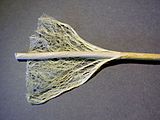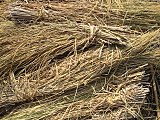AY Honors/Mat Making/Answer Key
1. In your culture name the materials which are used in mat making.
Mats are made of many, many different types of material, including:
- Coir (coconut fibers)
- Reeds
- Bulrushes (including cattails)
- Hemp
- Rattan (cane)
- Various grasses
- Straw
- Palm leaves
- Screw pine (Pandanus) leaves
2. Explain and demonstrate how to prepare this material.
Coir
Green coconuts, harvested after about six to twelve months on the plant, contain pliable white fibres. Brown fibre is obtained by harvesting fully mature coconuts when the nutritious layer surrounding the seed is ready to be processed into copra and desiccated coconut. The fibrous layer of the fruit is then separated from the hard shell (manually) by driving the fruit down onto a spike to split it (De-husking). A well seasoned husker can manually separate 2,000 coconuts per day. Machines are now available which crush the whole fruit to give the loose fibres. These machines can de-husk up to 2,000 coconuts per hour.
- Brown fibre
The fibrous husks are soaked in pits or in nets in a slow moving body of water to swell and soften the fibres. The long bristle fibres are separated from the shorter mattress fibres underneath the skin of the nut, a process known as wet-milling. The mattress fibres are sifted to remove dirt and other rubbish, dried in the sun and packed into bales. Some mattress fibre is allowed to retain more moisture so that it retains its elasticity for 'twisted' fibre production. The coir fibre is elastic enough to twist without breaking and it holds a curl as though permanently waved. Twisting is done by simply making a rope of the hank of fibre and twisting it using a machine or by hand. The longer bristle fibre is washed in clean water and then dried before being tied into bundles or hunks. It may then be cleaned and 'hackled' by steel combs to straighten the fibres and remove any shorter fibre pieces. Coir bristle fibre can also be bleached and dyed to obtain hanks of different colours.
- White fibre
The immature husks are suspended in a river or water-filled pit for up to ten months. During this time micro-organisms break down the plant tissues surrounding the fibres to loosen them — a process known as retting. Segments of the husk are then beaten by hand to separate out the long fibres which are subsequently dried and cleaned. Cleaned fibre is ready for spinning into yarn using a simple one-handed system or a spinning wheel.
Reeds, Bullrushes, and Grass
Hemp
Rattan
Generally, raw rattan is processed into several products to be used as materials in furniture making. The various species of rattan ranges from several millimetres up to 5-7 cm in diameter. From a strand of rattan, the skin is usually peeled off, to be used as rattan weaving material.
Straw
Palm leaves
Screw pine
3. Name plants that can be used for making dyes in your culture. Tell where they come from and how to prepare them for dying.
Rattan
The fruit of some rattans exudes a red resin called dragon's blood. This resin was used as a dye for violins, among other things. The resin normally results in a wood with a light peach hue.
Dragon's blood resin is produced from the rattan palms of the genus Daemonorops of the Indonesian islands and known there as jerang or djerang. It is gathered by breaking off the layer of red resin encasing the unripe fruit of the rattan. The collected resin is then rolled into solid balls before being sold.
4. Show how to use native and synthetic dyes in dyeing mat making material.
Template:Adventist Youth Honors Answer Book/Natural dyes






